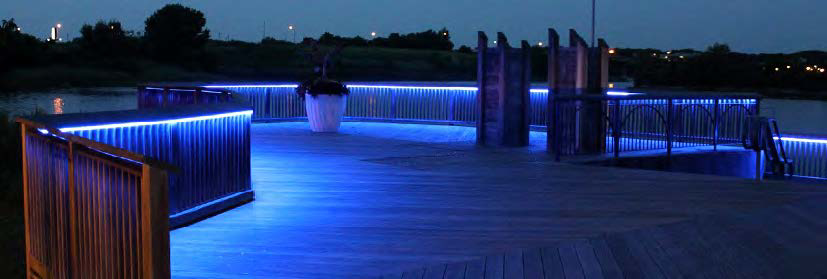Illuminating Architectural Wonders: Unleashing the Potential of LED Lighting Strips in Architecture and Interiors
LED lighting strips have revolutionised the way we illuminate our surroundings. With their versatility, energy efficiency, and durability, these strips have become the go-to choice for architects, interior designers, and lighting enthusiasts alike. They offer many advantages over traditional lighting options, such as compact size, flexible form factor, and a wide range of colour options, making them an ideal choice for architectural lighting applications.
A Game-Changer in LED Lighting
Among the wide array of LED lighting strip products available, Acolyte’s Ribbonlyte from Acolyte stands out as a true game-changer. With its cutting-edge technology and unparalleled performance, Acolyte’s Ribbonlyte opens up endless creative possibilities for architects and designers. This product features high-quality LEDs mounted on a flexible circuit board, enabling seamless integration into architectural elements, both indoors and outdoors.

Image copyright: Heritage Park
Lighting Design: Christian Rae Studio, LLC
Location: Norwalk, CT
Elevating Architecture with Acolyte’s Ribbonlyte
Ribbonlyte empowers architects and designers to transform ordinary spaces into extraordinary works of art. Its versatility allows it to be incorporated into a wide range of architectural applications, including:
- Accent Lighting: Highlight architectural features, such as coves, arches, or columns, with dynamic lighting effects using Ribbonlyte. The flexibility of the strips allows for precise detailing and seamless integration, enhancing the overall aesthetics of the space.
- Cove Lighting: Create a soft, ambient glow by installing Ribbonlyte in coves along ceilings or walls. The ability to produce a wide spectrum of colours and adjustable brightness levels enables architects to achieve the desired mood and ambience in any environment.
- Pathway and Step Lighting: Enhance safety and add a touch of elegance to staircases, walkways, and paths with Ribbonlyte. The strips can be discreetly installed to provide guidance and accentuate architectural lines, all while consuming minimal energy.
- Outdoor Lighting: Ribbonlyte’s weather-resistant properties make it perfect for illuminating exteriors. Illuminate facades and landscapes, or even create stunning lighting displays for public spaces, all while enjoying the long lifespan and energy efficiency of LED technology.
Benefits of Acolyte’s Ribbonlyte and LED Lighting Strips
- Energy Efficiency: LED lighting strips consume significantly less energy than traditional lighting sources, resulting in lower electricity costs and reduced environmental impact.
- Longevity: Acolyte’s Ribbonlyte boasts an impressive lifespan, ensuring long-term reliability and reduced maintenance requirements, making it an ideal choice for both commercial and residential projects.
- Design Flexibility: The slim and flexible form factor of Ribbonlyte enables seamless integration into various architectural elements, offering unmatched design possibilities.
- Colour Customization: LED lighting strips allow for precise colour control and customisation, empowering designers to create captivating lighting scenes that align with a space’s desired atmosphere and mood.
Acolyte’s Ribbonlyte is a unique product that takes lighting design to new heights. Its versatility, energy efficiency, and striking visual effects make it an invaluable tool for shopfitters, architects, interior designers, and lighting enthusiasts. With Acolyte’s Ribbonlyte, the possibilities are endless.

Image copyright: Hardrock Hotel
Location: Hollywood, FL, U.S.
Lighting Design: Focus Lighting
Applications: Cove lighting
Products: 3.0 Matrix Static White RibbonLyte
Photographer: Miami in Focus, Inc.
LED Strips Trends
LED lighting strips have become increasingly popular in interior and architectural design, with several notable trends emerging in their usage. Here are some of the top trends:
- Indirect Lighting: LED strips are commonly used for indirect lighting, where the light source is concealed or hidden from direct view. This technique creates a soft and diffused illumination, enhancing a space’s ambience and visual appeal. Indirect lighting is often employed in cove lighting, recessed ceilings, or behind architectural elements such as shelves or headboards.
- Accentuating Architectural Features: LED strips are versatile for highlighting architectural features and creating focal points. They can be installed along edges, outlines, or contours of structures, drawing attention to the unique design elements of a space. LED strips add depth and visual interest by emphasizing architectural details such as arches, columns, or textured walls.
- Colour Changing and Dynamic Lighting Effects: LED strips offer the ability to change colours and create dynamic lighting effects, enabling designers to transform the ambience and mood of a room. With the help of intelligent lighting controls, users can adjust the colour temperature, brightness and even create animated lighting sequences. This trend is prevalent in hospitality venues, entertainment spaces, and homes seeking versatile lighting options.
- Under Cabinet and Task Lighting: LED strips are commonly used as under cabinet lighting in kitchens and bathrooms, providing functional illumination for tasks while adding a touch of sophistication. These strips offer efficient and glare-free lighting, making them ideal for countertop workspaces and enhancing the area’s overall functionality.
- Creative Installations and Patterns: Designers increasingly use LED strips to create unique installations and patterns that become visual focal points in space. Whether it’s a geometric arrangement, a flowing curve, or an intricate design, LED strips offer the flexibility to shape and bend to suit various creative concepts. These installations can be seen in lobbies, retail displays, art installations, and other architectural features.
- Interactive Lighting: With advancements in sensor technology, LED strips are being integrated into interactive lighting installations. These installations respond to human presence, movement, or touch, creating engaging and immersive experiences. Interactive LED lighting can be found in museums, galleries, exhibits, and residential applications.
- Integration with Smart Home Systems: LED strips are being integrated into smart home systems, allowing users to control their lighting remotely or through voice commands. With the help of home automation platforms, users can customize lighting scenes, schedules, and colour settings, offering convenience, energy efficiency, and the ability to create personalized lighting experiences.
Incorporating LED lighting strips into interior and architectural design opens up a world of possibilities, enabling designers to push creative boundaries and enhance the visual impact of spaces. These trends showcase the versatility and transformative potential of LED strips in contemporary design practices.

